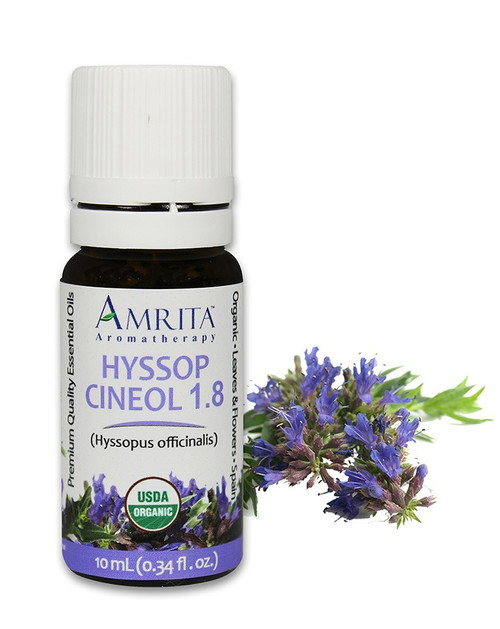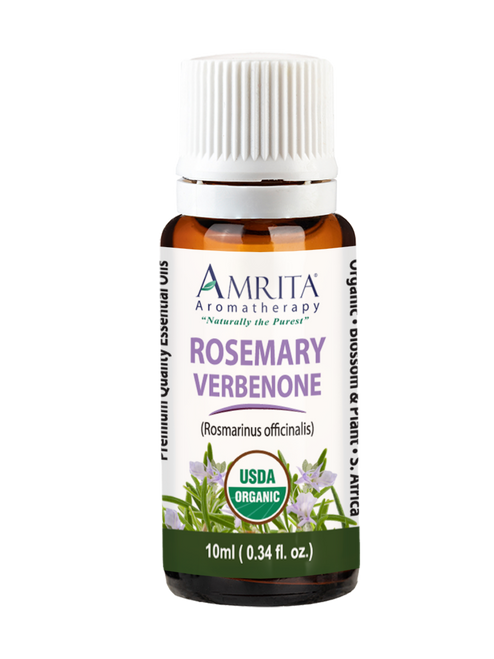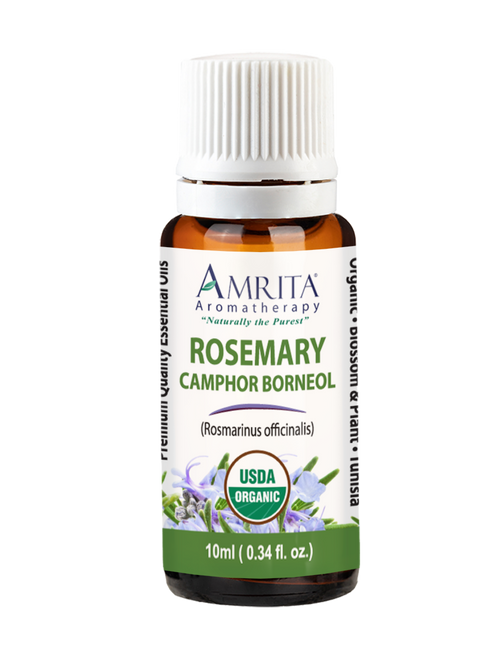- Other Names
- Common Rosemary
- Farming Method
- Certified Organic
- Plant Part
- Blossom and Plant
- Country of Origin
- Tunisia
- Application Method
- Bath, Diffusion, Inhalation, Massage, and Topical
- Scientific Name
- Rosmarinus officinalis
- Extraction Method
- Steam Distilled
About the Plant:
A shrubby evergreen bush, Rosemary grows up to 6 feet high. It has silvery-green, leathery, needle-shaped leaves and small tubular, pale blue flowers. The shrubs prefer growing in sunny well drained soil although adapt to most conditions and can be grown as a low border in a formal garden. The name “rosemary” means “rose of the sea,” referring to its native habitat, the sandy Mediterranean coastline. Rosemary loves dry heat: the hotter and drier the climate, the stronger its penetrating aroma.*
As rosemary is highly aromatic, it is not troubled by pests and diseases. This is why Rosemary has such a wide range of culinary and medicinal uses; Rosemary is also used to fragrance soaps, cosmetics, detergents, and perfumes.* Rosemary Cineol 1.8 Essential Oil contains a high amount of cineol compared to other Rosemary varieties, which gives it a warming and slightly eucalyptus-like aroma that is used for supporting healthy lungs, circulation and cleansing.*
Where It Grows:
Rosemary is a shrub that originated in the Mediterranean region. Today, it is now cultivated worldwide throughout the temperate regions especially in California, Russia, the Middle East, England, France, Spain, Portugal, Yugoslavia, Morocco, Tunisia, and China. Amrita Aromatherapy is proud to carry Organic Rosemary Cineol 1.8 from Tunisia.
Traditional Uses and Lore:
Rosemary is believed to be one of the earliest plants used for cooking and medicine. The ancient Egyptians favored it and traces of it has been found in the first dynasty tombs.* Rosemary was burnt as ritual incense and placed in the Pharaoh’s tombs to help them remember their former life.* This is why Rosemary is the herb known as a symbol of remembrance.*
It’s is said that Greek scholars placed rosemary wreaths on their heads to increase their power of concentration before exams.* Dioscorides recommended it as a powerful remedy for stomach and liver problems.* Hippocrates said rosemary should be cooked with vegetables to overcome liver and spleen disorders and Galen prescribed it for jaundice.*
To the Greeks and Romans, it was considered a sacred plant. They believed rosemary symbolized love and death.* The Greeks and Romans wove rosemary twigs into their wedding crowns and bouquets as a symbol of love and constancy, and burnt it as incense at funerals in respect and memory of the dead.* In the Middle Ages, it was burned to drive away evil spirits, to protect against plagues, and used to freshen and purify the air in French hospitals.*
First distilled in the 13th century, the Essential Oil of rosemary was an important ingredient in a number of eau de colognes.* Isabella, Queen of Hungary, had much to do with rosemary’s reputation as a rejuvenating tonic.* Her famous Royal Hungarian Water is made by distilling rosemary, lavender, rose petals, orange flower and lemon balm.*
Other Facts:
-
-
- Scent: Herbal, Warming, and Slightly Eucalyptus Aroma
- Fragrance Note: Middle Note
- Composition: Cineol, Pinene, Camphene, Camphor, and Bornyl Acetate
- Family: Lamiaceae Family
-
*These statements have not been evaluated by the Food and Drug Administration. These products are not intended to diagnose, treat, cure, or prevent any disease.
- USDA Certified Organic
- Supports Memory
- Aids Concentration
- Alleviating Respiratory Ailments
- All About Rosemary Cineol 1.8 Organic Essential Oil
Rosemary Cineol 1.8 Organic Essential Oil has its main effect on the respiratory organs and the nervous system.* It is best used for alleviating respiratory ailments like mucous, bronchitis, and sinusitis.* It also supports all mental functions and creates alertness.*
In aromatherapy, Rosemary Essential Oil will appear as one of three main chemotypes – cineol, camphor, or verbenone – each of which has different applications. The aroma and constituent profile of Rosemary oil varies according to: where the plants grow (altitude and climate), what plant parts are distilled, and whether the plant material is fresh or dried when distilled.
Topical Application (for use on the skin):
|
||
|
|
||
|
|
Diffusion / Inhalation (add a few drops to a nebulizer or nasal inhaler):
|
|
-------------------------------------------------------------------------------------------------------------------------------------------------------------------
Blends Well With:
-------------------------------------------------------------------------------------------------------------------------------------------------------------------
Safety Precautions:
-
- Rosemary Cineol 1.8 is non-toxic, non-irritant (when properly diluted), and non-sensitizing.*
- Avoid use if you have epilepsy, high blood pressure or are pregnant.*
- Rosemary Essential Oil should not be used on children who are 3 years of age or younger.*
- Rosemary Cineol 1.8 is non-toxic, non-irritant (when properly diluted), and non-sensitizing.*
General Safety Precautions:
-
- Use Essential Oils only in diluted form on the skin and never internally.
- Always be careful when using Essential Oils with children.
- Give them only low doses, or better, consult a qualified aromatherapy expert before using.
- Also, use Essential Oils with care and only under the proper guidance of an expert while pregnant or if you have liver damage, epilepsy, cancer, or other serious health problems.
*These statements have not been evaluated by the Food and Drug Administration. These products are not intended to diagnose, treat, cure, or prevent any disease.
Rosemary has a distinctive, fresh aroma that can wake up the senses and provide benefits to both body and spirit. It has been used to improve chronic fatigue, respiratory conditions such as asthma or allergies; mental functions like memory retention and overall brain health.* It also helps with mental clarity especially when it comes time memorize things or concentrate on tasks at hand!*
Rosemary is not just a stabilizer for your digestive system, but also an expectorant/decongestant and pain killer.* It's been proven to help with circulation problems in the pelvis region as well!* Rosemary contains camphor which can improve respiratory function by increasing blood flow all around it.* The oils from this herb have many therapeutic benefits including treating low moods or anxiety due its strong influence on humans - making them great additions when you're feeling down.*
Rosemary has been used for centuries as an herb to help with many ailments.* It contains camphor, which can increase blood flow and respiratory function* Rosemary Oil is also diuretic and expectorant/decongestant.* The traditional use of rosemary applies well when ingested or applied topically - it's useful in treating palpitations due its ability regulate Qi levels among other things!*
The following is a list of conditions which Rosemary Cineol 1.8 Essential Oil addresses by category:
|
|
|
|
*These statements have not been evaluated by the Food and Drug Administration. These products are not intended to diagnose, treat, cure, or prevent any disease.
Bottles are filled by volume. Some bottle sizes may not be filled to the top, but do contain the volume of oil specified.
|
Click the links below to view GC Analysis: |
Click the links below to view CoA Analysis: |
|
Click the link below to view Safety Data Sheet (SDS): |
1 Review Hide Reviews Show Reviews
-
All of their single blend products are very pure.
Love it and all of my single note products.











